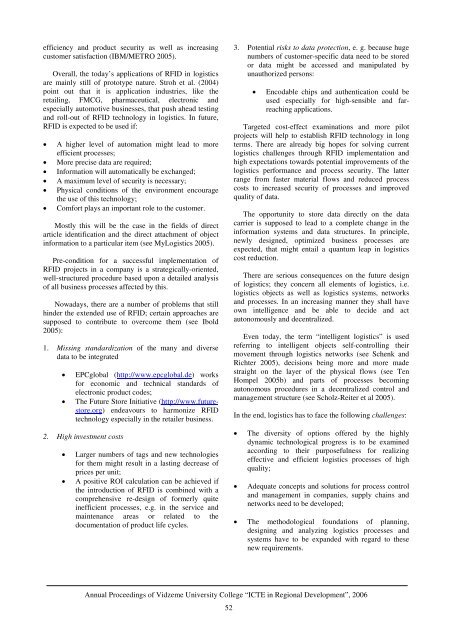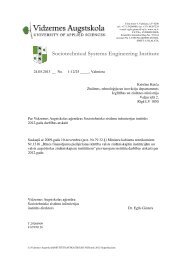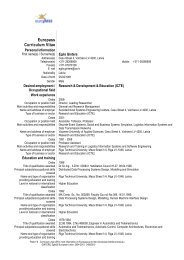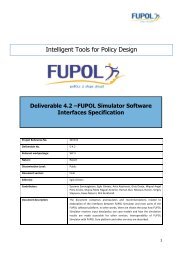efficiency and product security as well as <strong>in</strong>creas<strong>in</strong>gcustomer satisfaction (IBM/METRO 2005).Overall, the today’s applications of RFID <strong>in</strong> logisticsare ma<strong>in</strong>ly still of prototype nature. Stroh et al. (2004)po<strong>in</strong>t out that it is application <strong>in</strong>dustries, like theretail<strong>in</strong>g, FMCG, pharmaceutical, electronic andespecially automotive bus<strong>in</strong>esses, that push ahead test<strong>in</strong>gand roll-out of RFID technology <strong>in</strong> logistics. In future,RFID is expected to be used if:• A higher level of automation might lead to moreefficient processes;• More precise data are required;• In<strong>format</strong>ion will automatically be exchanged;• A maximum level of security is necessary;• Physical conditions of the environment encouragethe use of this technology;• Comfort plays an important role to the customer.Mostly this will be the case <strong>in</strong> the fields of directarticle identification and the direct attachment of object<strong>in</strong><strong>format</strong>ion to a particular item (see MyLogistics 2005).Pre-condition for a successful implementation ofRFID projects <strong>in</strong> a company is a strategically-oriented,well-structured procedure based upon a detailed analysisof all bus<strong>in</strong>ess processes affected by this.Nowadays, there are a number of problems that stillh<strong>in</strong>der the extended use of RFID; certa<strong>in</strong> approaches aresupposed to contribute to overcome them (see Ibold2005):1. Miss<strong>in</strong>g standardization of the many and diversedata to be <strong>in</strong>tegrated• EPCglobal (http://www.epcglobal.de) worksfor economic and technical standards ofelectronic product codes;• The Future Store Initiative (http://www.futurestore.org)endeavours to harmonize RFIDtechnology especially <strong>in</strong> the retailer bus<strong>in</strong>ess.2. High <strong>in</strong>vestment costs• Larger numbers of tags and new technologiesfor them might result <strong>in</strong> a last<strong>in</strong>g decrease ofprices per unit;• A positive ROI calculation can be achieved ifthe <strong>in</strong>troduction of RFID is comb<strong>in</strong>ed with acomprehensive re-design of formerly quite<strong>in</strong>efficient processes, e.g. <strong>in</strong> the service andma<strong>in</strong>tenance areas or related to thedocumentation of product life cycles.3. Potential risks to data protection, e. g. because hugenumbers of customer-specific data need to be storedor data might be accessed and manipulated byunauthorized persons:• Encodable chips and authentication could beused especially for high-sensible and farreach<strong>in</strong>gapplications.Targeted cost-effect exam<strong>in</strong>ations and more pilotprojects will help to establish RFID technology <strong>in</strong> longterms. There are already big hopes for solv<strong>in</strong>g currentlogistics challenges through RFID implementation andhigh expectations towards potential improvements of thelogistics performance and process security. The latterrange from faster material flows and reduced processcosts to <strong>in</strong>creased security of processes and improvedquality of data.The opportunity to store data directly on the datacarrier is supposed to lead to a complete change <strong>in</strong> the<strong>in</strong><strong>format</strong>ion systems and data structures. In pr<strong>in</strong>ciple,newly designed, optimized bus<strong>in</strong>ess processes areexpected, that might entail a quantum leap <strong>in</strong> logisticscost reduction.There are serious consequences on the future designof logistics; they concern all elements of logistics, i.e.logistics objects as well as logistics systems, networksand processes. In an <strong>in</strong>creas<strong>in</strong>g manner they shall haveown <strong>in</strong>telligence and be able to decide and actautonomously and decentralized.Even today, the term “<strong>in</strong>telligent logistics” is usedreferr<strong>in</strong>g to <strong>in</strong>telligent objects self-controll<strong>in</strong>g theirmovement through logistics networks (see Schenk andRichter 2005), decisions be<strong>in</strong>g more and more madestraight on the layer of the physical flows (see TenHompel 2005b) and parts of processes becom<strong>in</strong>gautonomous procedures <strong>in</strong> a decentralized control andmanagement structure (see Scholz-Reiter et al 2005).In the end, logistics has to face the follow<strong>in</strong>g challenges:• The diversity of options offered by the highlydynamic technological progress is to be exam<strong>in</strong>edaccord<strong>in</strong>g to their purposefulness for realiz<strong>in</strong>geffective and efficient logistics processes of highquality;• Adequate concepts and solutions for process controland management <strong>in</strong> companies, supply cha<strong>in</strong>s andnetworks need to be developed;• The methodological foundations of plann<strong>in</strong>g,design<strong>in</strong>g and analyz<strong>in</strong>g logistics processes andsystems have to be expanded with regard to thesenew requirements.Annual <strong>Proceed<strong>in</strong>gs</strong> of Vidzeme University College “ICTE <strong>in</strong> Regional Development”, 200652
Table 1. Examples for <strong>in</strong>troduc<strong>in</strong>g RFID technology to the retailer bus<strong>in</strong>ess (translated from IBM/METRO 2005).METRO Group Wal-Mart TescoNov 2004:Mark<strong>in</strong>g the pallets of about 20<strong>in</strong>dustrial partners from FMCG byuse of RFIDFrom Jan 2006 (as planned):Extend<strong>in</strong>g the number of <strong>in</strong>volvedsuppliers and retailers step-by-stepJan 2005:Attach<strong>in</strong>g RFID transponders topallets and boxes of the hundredlargest suppliersUntil the end of 2005 (as planned)Us<strong>in</strong>g RFID technology <strong>in</strong> 12warehouses and 600 retailer shopsNov 2004:Mark<strong>in</strong>g boxes by use of RFID (to becont<strong>in</strong>ued <strong>in</strong> Feb 2005)Until Jan 2007 (as planned):Mark<strong>in</strong>g all supplies alongside thewhole process cha<strong>in</strong> by use of RFIDPROCESS INTELLIGENCE WITH LOGISTICSOBJECTSIn its widest mean<strong>in</strong>g the term <strong>in</strong>telligence describesthe ability to see l<strong>in</strong>ks and to f<strong>in</strong>d optimal problemsolutions. It is related to the ability of a human be<strong>in</strong>g toconsciously adjust his/her th<strong>in</strong>k<strong>in</strong>g to new requirementsand with this refers to the general <strong>in</strong>tellectual adaptabilityto new tasks and conditions of life (see Stern 1912). Inthe context of problem solv<strong>in</strong>g this means on one handthe ability to creatively f<strong>in</strong>d solutions and their limits andon the other hand to <strong>in</strong>ternally weigh up alternativeactions before act<strong>in</strong>g (<strong>in</strong> the sense of a test-action).In the context of modern logistics it is assumed thatsimilar abilities can be achieved with logistics objects(i.e. goods and load carriers) when RFID and powerfulsensor technologies are used. This shall enable logisticsobjects to <strong>in</strong>dependently communicate with the plann<strong>in</strong>gand monitor<strong>in</strong>g systems, identify themselves, and <strong>in</strong>formabout the own state. But to fully meet the deepermean<strong>in</strong>g of <strong>in</strong>telligence as expla<strong>in</strong>ed above and let thoseobjects really become <strong>in</strong>telligent it is not enough just tobe able to actively or passively perceive the environmentand the chang<strong>in</strong>g situations. Additionally, objects mustbe provided with a logistics-oriented control and decisionlogic.In perspective, this is to be achieved throughmicrochips with <strong>in</strong>creased memory enabl<strong>in</strong>g a s<strong>in</strong>gleobject not only to <strong>in</strong>dependently f<strong>in</strong>d its way through thematerial flow system <strong>in</strong>clud<strong>in</strong>g all cross<strong>in</strong>gs, but also to<strong>in</strong>dependently allocate resources required for be<strong>in</strong>gprocessed or to look for a by-pass <strong>in</strong> case of bottle-necksituations (see Bear<strong>in</strong>gPo<strong>in</strong>t 2005). This way, logisticsobjects would be enabled to act accord<strong>in</strong>g to currentenvironmental conditions and eventually changedrequirements.To a limited extent, namely with the focus on themomentary constellation <strong>in</strong> the local surround<strong>in</strong>gs, predef<strong>in</strong>edalternatives of action can be weighed up. But toreally estimate the consequences of an action <strong>in</strong> the senseof the above mentioned test-action the object needssimulation competence. To provide this through a predef<strong>in</strong>edsimulation model <strong>in</strong>tegrated <strong>in</strong>to the object, thatis a special challenge.The task to realize foresighted action <strong>in</strong> a complexsurround<strong>in</strong>g is even more ambitious, because for this theobject not only has to perceive its nearest environmentfrom a local po<strong>in</strong>t of view, but also needs to take up aglobal perspective towards the process as a whole<strong>in</strong>clud<strong>in</strong>g complex <strong>in</strong>teractions and compet<strong>in</strong>g object<strong>in</strong>terests.Exactly this is the pre-condition for true process<strong>in</strong>telligence of a self-determ<strong>in</strong>ed act<strong>in</strong>g object, because alogistics process does not only result from locallyfocused activities of a s<strong>in</strong>gle object with <strong>in</strong>dividualtargets and constra<strong>in</strong>ts, but from the entirety of alloperations and the superposition of the different objectlives. If here an object “th<strong>in</strong>ks” only of itself, thenconflicts and less optimal processes are pre-programmed.Consequently, process <strong>in</strong>telligence less requires anegocentric, object-focused process view, but much morecomprehensive process <strong>in</strong><strong>format</strong>ion <strong>in</strong>stead which notonly can result from object-specific perceptions; theyneed to <strong>in</strong>clude object and system <strong>in</strong><strong>format</strong>ion as well:• Object <strong>in</strong><strong>format</strong>ion are characteristics of goods orunits relevant to their physical process<strong>in</strong>g such asID, location, state of be<strong>in</strong>g processed, sequence ofoperations, type, quantity/colour/size etc.;• System <strong>in</strong><strong>format</strong>ion comprise characteristics of the(static) structure (<strong>in</strong> the form of elements and theirl<strong>in</strong>ks to each other) of a system as well as thesystem’s or its elements’ (dynamically chang<strong>in</strong>g)states accord<strong>in</strong>g to availability, reservation,occupation, break<strong>in</strong>g-down etc. <strong>in</strong>fluenc<strong>in</strong>g itsability to run material flow processes;• Process <strong>in</strong><strong>format</strong>ion describe the structure of thephysical processes (i.e. permanent or temporaryprocess cha<strong>in</strong>s of operations and their l<strong>in</strong>ks to eachother), their states, decision problems related to themand strategies/rules applicable to solve them,Annual <strong>Proceed<strong>in</strong>gs</strong> of Vidzeme University College “ICTE <strong>in</strong> Regional Development”, 200653
- Page 1 and 2:
ISBN 9984-633-03-9Annual Proceeding
- Page 3 and 4:
“Development of Creative Human -
- Page 5 and 6:
TABLE OF CONTENTSINTELLIGENT SYSTEM
- Page 7 and 8: INTELLIGENT SYSTEM FOR LEARNERS’
- Page 9 and 10: LEARNER 1GROUP OF HUMAN AGENTSLEARN
- Page 11 and 12: QuantityQuantityFigure 6. Distribut
- Page 13 and 14: LEARNERStructure of theconcept mapL
- Page 15 and 16: WEB-BASED INTELLIGENT TUTORING SYST
- Page 17 and 18: materials to be presented and which
- Page 19 and 20: INFORMATION TECHNOLOGIES AND E-LEAR
- Page 21 and 22: correspondence with the course aim
- Page 23 and 24: projects and through IT. Hence, it
- Page 25 and 26: APPLICATION OF MODELING METHODS IN
- Page 27 and 28: can support configuration managemen
- Page 29 and 30: The EKD is one of the Enterprise mo
- Page 31 and 32: CHANGES TO TRAINING AND PERSPECTIVE
- Page 33 and 34: or an end, yet none of these attitu
- Page 35 and 36: make decisions. It cannot be volunt
- Page 37 and 38: logs), data and video conferencing
- Page 39 and 40: Ability to follow user’s multi-ta
- Page 41 and 42: CONCLUSIONSEDUSA method gives us a
- Page 43 and 44: in successful SD. Given this situat
- Page 45 and 46: SPATIAL INFORMATIONFor the visualis
- Page 47 and 48: MOBILE TECHNOLOGIES USE IN SERVICES
- Page 49 and 50: learning environment (Learning Mana
- Page 51 and 52: ago only some curricula on Logistic
- Page 53 and 54: The Web-based version can be access
- Page 55 and 56: Web-portal, which incorporates diff
- Page 57: DO INTELLIGENT OBJECTS AUTOMATICALL
- Page 61 and 62: workable influencing of the process
- Page 63 and 64: are handed over to the objects and
- Page 65 and 66: • Basic processes, such as wareho
- Page 67 and 68: THE ECR E-COACH: A VIRTUAL COACHING
- Page 69 and 70: participating in the workshops and
- Page 71 and 72: • Assessment modules enable indiv
- Page 73 and 74: with pictures and illustrated graph
- Page 75 and 76: ECR Question Banknumber category su
- Page 77 and 78: educational programme that follows
- Page 79 and 80: DEVELOPMENT OF WEB BASED GRAVITY MO
- Page 81 and 82: These results of a model require a
- Page 83 and 84: CONCLUSIONSThe main goal of work ha
- Page 85 and 86: dimension and included within any o
- Page 87 and 88: • Resources sharing by providing
- Page 89 and 90: Pursuant to the guidelines of elect
- Page 91 and 92: tariffs of regulated services have
- Page 93 and 94: INFORMATION TECHNOLOGY FOR MOTIVATI
- Page 95 and 96: difficult to predict when and for w
- Page 97 and 98: Listeners' workon the WebListenersS
- Page 99 and 100: PERSPECTIVES OF WEB PAGE AND E-MAIL
- Page 101 and 102: INCREASE IN THE NUMBER OF INTERNETU
- Page 103 and 104: tourism accommodations (home pages
- Page 105 and 106: interactive relationships with clie
- Page 107 and 108: • The data obtained by the resear
- Page 109 and 110:
Central Statistical Bureau of Latvi
- Page 111 and 112:
departures for 1995 are taken from
- Page 113 and 114:
120100maximumworldminimum806040200-
- Page 115 and 116:
140120maximumworldminimum1008060402
- Page 117 and 118:
would be a promising extension. Cur
- Page 119 and 120:
AN OVERVIEW OF THE AGENT − BASED
- Page 121 and 122:
Suitability for social system simul
- Page 123 and 124:
6. MASONDescription:MASON is a fast
- Page 125 and 126:
Suitability for social system simul
- Page 127 and 128:
could be bad particularly when over
- Page 129 and 130:
(for 10 repeat &| CCar[]->runfor);P
- Page 131 and 132:
• Streaming audio• Collaboratio
- Page 133 and 134:
NECESSITY OF NEW LAYERED APPROACH T
- Page 135 and 136:
Up to now, there has only been limi
- Page 137 and 138:
aaaaa6= −aa2,1 = − a0,3226= −
- Page 139 and 140:
∂ u∂x∂ u∂y2 2+ b = 02 2wher
- Page 141 and 142:
a6,3= −2030a4,5−130a4,3- - - -
- Page 143 and 144:
0,10,20,30,4( )Mag x y y Ge wx2, =
- Page 145 and 146:
Example 1. To understand better the
- Page 147 and 148:
Therefore, further the following co
- Page 149 and 150:
SOLUTION OF THE THREE-DIMENSIONALEQ
- Page 151 and 152:
Mag1, m , m , m1 2 3= mm1 m2m32 2 2
- Page 153 and 154:
MagMag0, m , m , m1 2 31, m , m , m
- Page 155:
CONCLUSIONSThe basic content of thi









